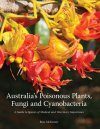About this book
Australia's Poisonous Plants, Fungi and Cyanobacteria is the first full-colour, comprehensive guide to the major natural threats to health in Australia affecting domestic and native animals and humans. The overriding aim of the book is to prevent poisoning, as there are few effective treatments available, particularly in domestic animals.
The species have been chosen because of their capacity to threaten life or damage important organs, their relative abundance or wide distribution in native and naturalised Australian flora, or because of their extensive cultivation as crops, pastures or in gardens. These include flowering plants, ferns and cone-bearing plants, macrofungi, ergot fungi and cyanobacteria.
The plant species are grouped by life form such as herbs, grasses and sedges, shrubs, trees, and for flowering plants by flower type and colour for ease of identification. Species described have colour photographs, distribution maps and notes on confusing species, habitats, toxins, animals affected, conditions of poisoning, clinical signs and symptoms, post mortem changes, therapy, prevention and control. Symbols are used for quick reference to poisoning duration and available ways of managing poisoning. As further aids to understanding, poisoning hot-spots are highlighted and the book lists plants under the headings of animals affected and organs affected. A Digest gives brief details for all poisonous species in Australia.
This book is written in a straightforward style making it accessible to a wide audience including farmers, veterinarians, agricultural advisors, gardeners, horticulturists, botanists and park rangers, medical practitioners and paramedics, teachers, parents and pet owners.
Contents
About the author
Preface: why this book?
Acknowledgements
Warnings
Using this book
1 Understanding plants and plant poisoning
2 How to confirm tentative identifications
3 Common poisoning profiles
Part 1 Poisonous cyanobacteria (blue-green algae)
Part 2 Poisonous fungi
Part 3 Poisonous vascular plants
Appendix 1: Aids to identifying flowering plants
Appendix 2: The top killers
Appendix 3: Poisoning hot-spots
Appendix 4: Animals and the major species that poison them
Appendix 5: Body systems affected by the major poisonous species
Appendix 6: Australian states with major poisonous species
Glossary
References and further reading
Index
Customer Reviews
Biography
Ross McKenzie is a retired veterinary pathologist, toxicologist and research scientist from the Queensland Department of Primary Industries where he diagnosed and researched diseases of livestock for 36 years (1973-2009). Known as `the whistling pathologist', he carried his fair share of the veterinary workload of the central diagnostic laboratory at Yeerongpilly in Brisbane, for instance personally handling 10,000 case accessions from livestock disease investigations throughout Queensland during 1990-2002. He is also a retired conjoint senior lecturer from the University of Queensland where he taught toxicology to veterinary students for 14 years (1994-2008). His students called him `Toxic Ross' and his 2007 class gave him a `Joie de Vivre' award for making the study of toxicology enjoyable. They had thought it would be deadly!
He earned a Bachelor of Veterinary Science degree (with Honours) from the University of Queensland at the start of his career, then the degrees of Master of Veterinary Science and Doctor of Veterinary Science some 20 years later, recognising his research achievements. He won the Australian Veterinary Association Excellence in Teaching Award for 2002, the Queensland Natural History Award for 2004 and in 2009 was honoured with the Public Service Medal within the Order of Australia for his research in veterinary pathology and toxicology. He has authored over 100 scientific publications reporting original contributions to knowledge and has contributed to several international veterinary text and reference books. He is now an Honorary Research Associate of Queensland Herbarium and of Biosecurity Queensland. He is also a (very) amateur botanist and photographer. His family roots are in the earth of the Maranoa district of rural Queensland. He lives in Brisbane with his wife Glenyth, and a garden containing many poisonous plants.



































